
Here’s another distant but approaching comet, first sighted by astronomers in 2017. When they spotted it, via the Pan-STARRS survey instrument in Hawaii, they said it was the farthest active inbound comet they’d yet seen. The comet is designated C/2017 K2 (PanSTARRS). It was between the orbits of Saturn and Uranus when they first saw it, but will finally make its way into the inner solar system this year. It’ll be closest to Earth on July 14, 2022. It’ll be closest to the sun several months later, on December 19, 2022. If you have a small telescope, you should be able to spot the comet for up to four months of this year.
Comets are mostly rock and ice. They become active when warmed by the sun. However, this comet was already active in 2017. The Hubble Space Telescope took an image of the comet looking like a fuzzy snowball while it was still in the outer solar system. The comet appears to have a large nucleus, and it shows a huge cometary atmosphere or coma.
The 2022 lunar calendars are here. Order yours before they’re gone!
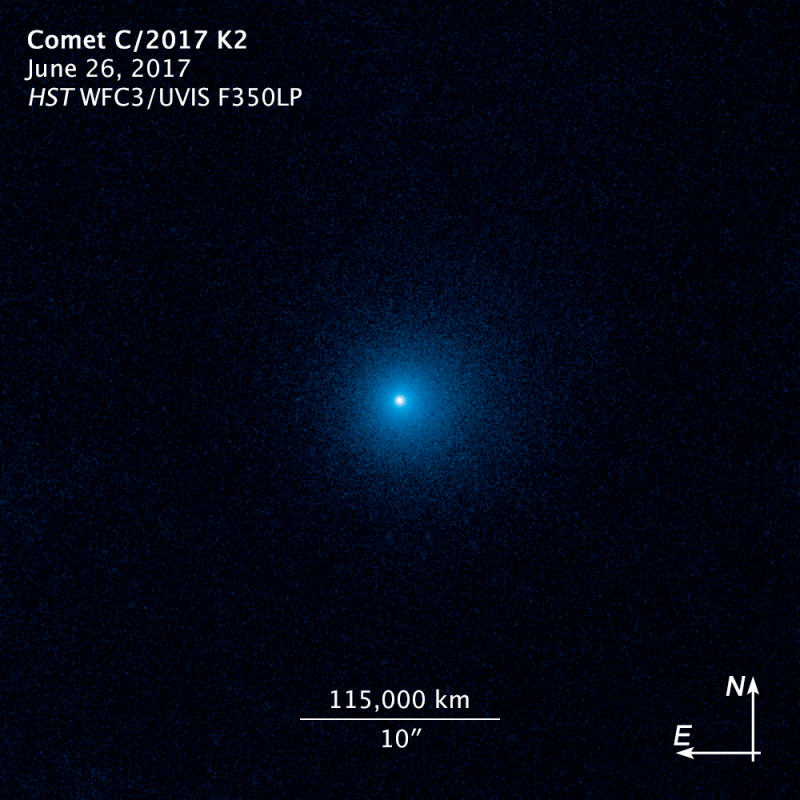
Comet C/2017 K2 (PanSTARRS)
If the name Comet PanSTARRS rings a bell, that’s because there are many of them. The Pan-STARRS is a sky survey that is particularly good at spotting new asteroids, comets, supernovae and the like. This is comet C/2017 K2 (PanSTARRS). At its discovery, K2 was 1.49 billion miles (2.4 billion km) from the sun.
By the way, the new title-holder for farthest active comet is Comet Bernardinelli-Bernstein. Astronomers spotted this behemoth comet, about 1,000 times the size of a normal comet, when it was more than 2.7 billion miles (4.4 billion km) from the sun. Comet “Bern-Bern” will have its closest approach on January 21, 2031. But you have nothing to fear from it, as it will be slightly farther away than Saturn’s orbit.
Comet C/2021 O3
Back to 2022, another “PanSTARRS” comet, C/2021 O3, might brighten into binocular range in late April or early May. But this may be the year to buy a telescope, because comet C/2017 K2 might be visible with a small telescope in the Northern Hemisphere for four months.
Below we have star charts for May through August to help you spot K2. Although it appears to be a large comet, it will probably remain a telescope object because it will pass some 168 million miles (270 million km) from Earth.
It should brighten to magnitude 7 or even 6, still too dim for the unaided eye. But you can easily spot an object of this magnitude in a small telescope. The darker the skies, the better the contrast will be.
How large is C/2017 K2?
Initial observations from the Canada–France–Hawaii Telescope (CFHT) suggest a nucleus with a diameter of 18 to 100 miles (29 to 161 km). But observations with the Hubble Space Telescope indicate the nucleus should be smaller, at some 11 miles (18 km) or less.
If the name K2 reminds you of the second largest mountain on Earth, also named K2, keep in mind that the mountain is 28,251 feet (8,611 meters) tall. If the comet K2 is around 11 miles or 18 km (a reasonable estimate), that translates to about 58,000 feet or 18,000 meters. In other words, the comet K2 dwarfs the mountain K2, which is about half its size.
Huge coma on C/2017 K2
Another indication that suggests C/2017 K2 is not small, or at least is very active, is that observations showed it developed a cometary atmosphere or coma with a diameter of about 81,000 miles (130,000 km). That’s a sphere of gasses 10 times the diameter of planet Earth, or almost as big as the diameter of planet Jupiter. That’s huge!
Also, some observations detected an incredibly large tail, some 500,000 miles (800,000 km) long.
Scientists think that comets that are too far from the sun shouldn’t sublimate huge amounts of ice. So this comet’s activity is probably driven by a mix of ices with substances like nitrogen, carbon dioxide, carbon monoxide and molecular oxygen.
Most comets have a nucleus of about 0.5 to 2 miles (1 to 3 km) in diameter, while others may be up to 10 miles (16 km) wide. However, a few are really huge, including Hale-Bopp (37 miles or 60 km), Bernardinelli-Bernstein (93 miles or 150 km) and 95P/Chiron, also known as 2060 Chiron) at 124 miles or 200 km. In fact, 95P/Chiron may be a dwarf planet. However, it showed cometary behavior and thus got a comet designation.
What to expect?
Observers using a small telescope (preferably from a dark-sky site) should be able to see a diffuse or fuzzy patch of light (the coma) around the nucleus of comet C/2017 K2. Careful observations using averted vision at the telescope may reveal the coma is really big compared to other comets. A hint of the comet’s tail might be visible, while long-exposure images should reveal the comet and its tail in all its glory.
Astronomers estimate that Comet C/2017 K2 (PanSTARRS) has been traveling from the Oort cloud for some 3 million years in a hyperbolic orbit. By January 2022, the celestial visitor will be some 466 million miles (750 million km) from Earth and gradually getting closer. Comet K2 will first become visible in small telescopes from the North Hemisphere from around June to September. After mid-September, it becomes closer to the horizon as seen from the Northern Hemisphere. Thereafter it will be best for observers in the Southern Hemisphere.
Finder maps for C/2017 K2
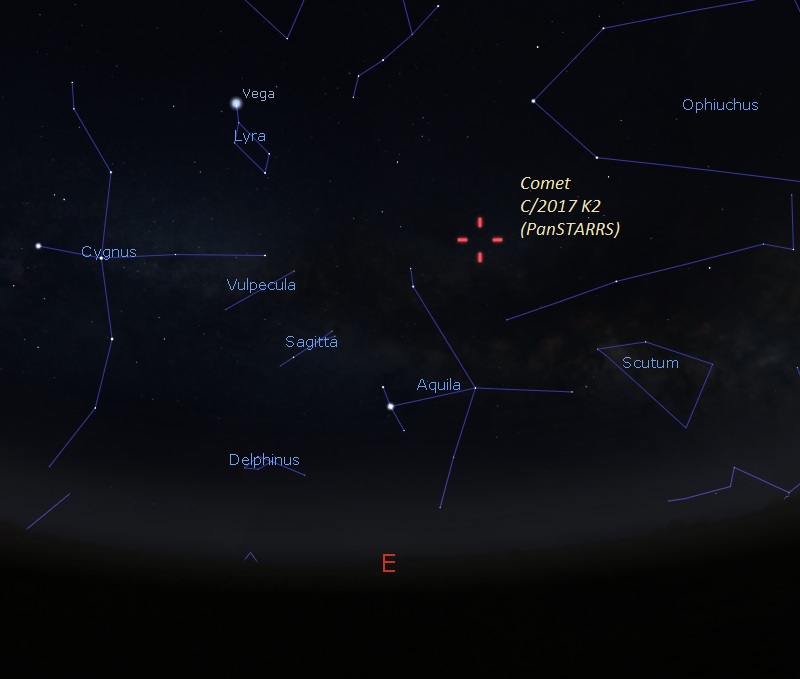
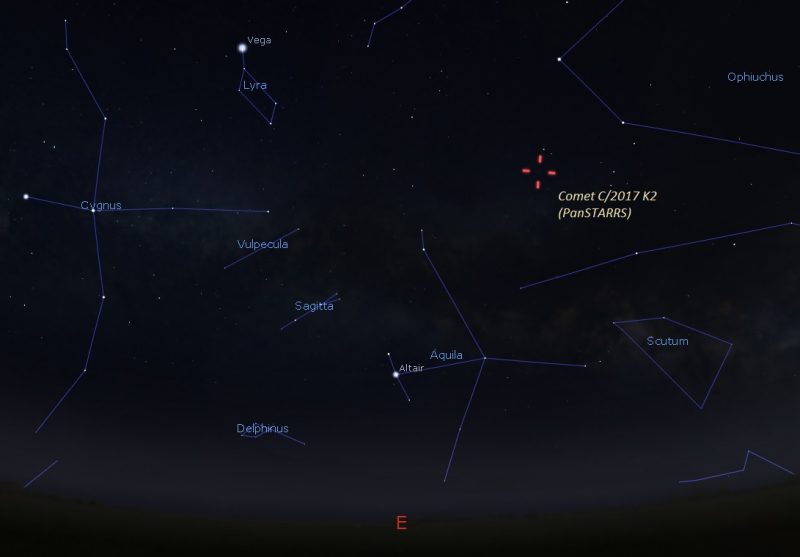
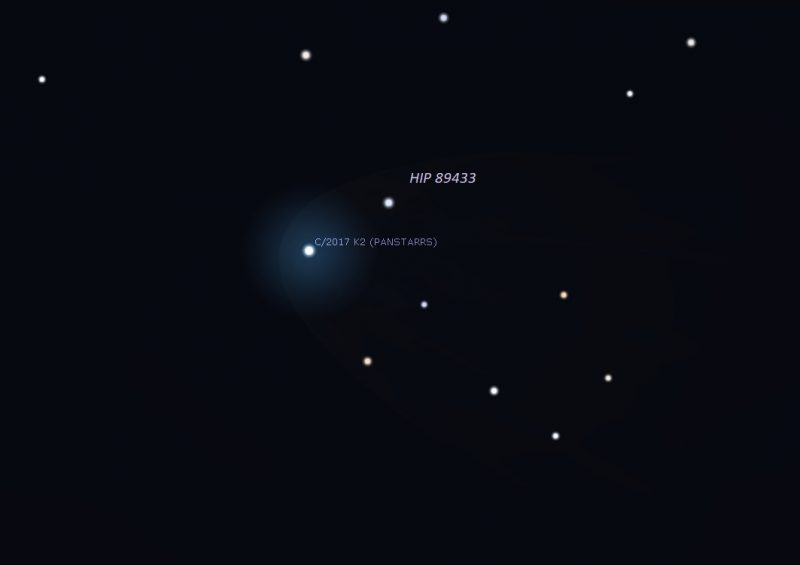
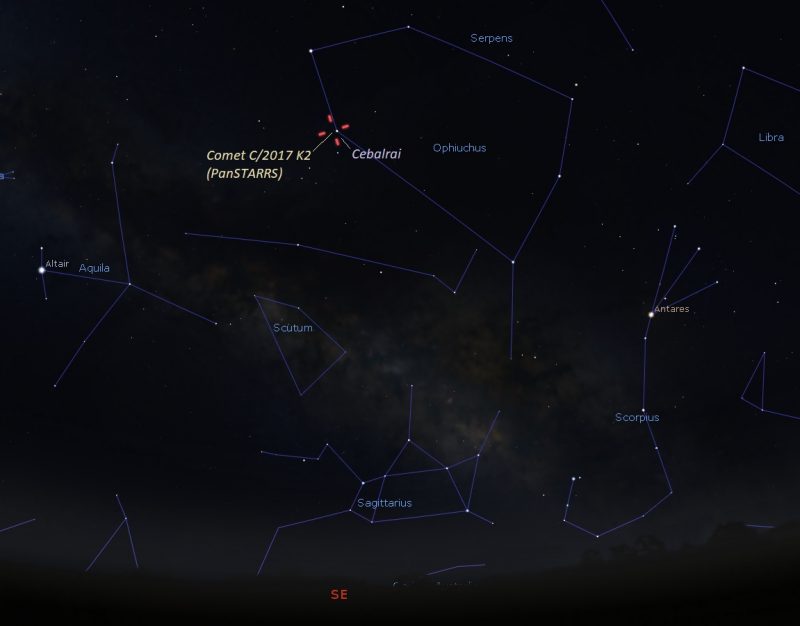


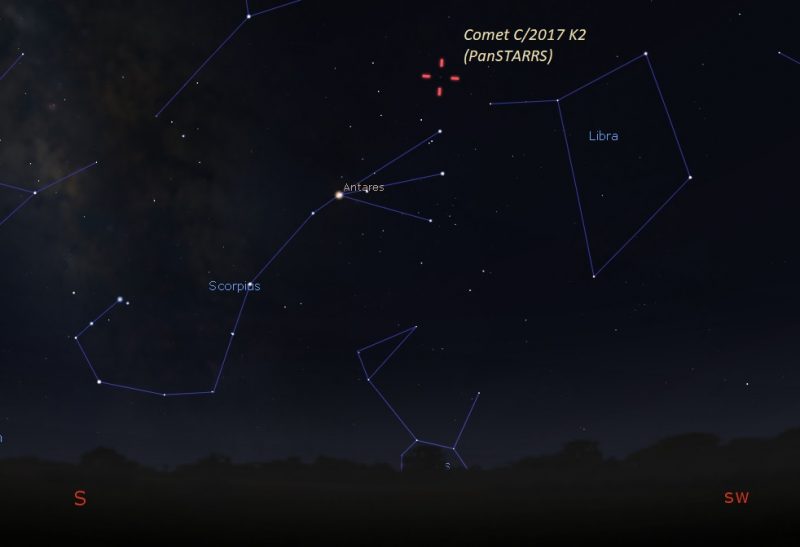

When will we see the next bright comet?
There is always the possibility that a newly found comet may provide a nice spectacle in our skies. From all the currently known comets, the next possible good one appears to be comet 12P/Pons-Brooks, which might reach magnitude 5 or 4 in March 2024.
Meanwhile, let’s see what Comet C/2017 K2 has in store for us. Look up!
Bottom line: Comet C/2017 K2 (PanSTARRS) will brighten in our skies this summer. You can watch it with a small telescope for four months.
The post Large comet C/2017 K2 to pass Earth in July 2022 first appeared on EarthSky.
from EarthSky https://ift.tt/3FHERm1

Here’s another distant but approaching comet, first sighted by astronomers in 2017. When they spotted it, via the Pan-STARRS survey instrument in Hawaii, they said it was the farthest active inbound comet they’d yet seen. The comet is designated C/2017 K2 (PanSTARRS). It was between the orbits of Saturn and Uranus when they first saw it, but will finally make its way into the inner solar system this year. It’ll be closest to Earth on July 14, 2022. It’ll be closest to the sun several months later, on December 19, 2022. If you have a small telescope, you should be able to spot the comet for up to four months of this year.
Comets are mostly rock and ice. They become active when warmed by the sun. However, this comet was already active in 2017. The Hubble Space Telescope took an image of the comet looking like a fuzzy snowball while it was still in the outer solar system. The comet appears to have a large nucleus, and it shows a huge cometary atmosphere or coma.
The 2022 lunar calendars are here. Order yours before they’re gone!

Comet C/2017 K2 (PanSTARRS)
If the name Comet PanSTARRS rings a bell, that’s because there are many of them. The Pan-STARRS is a sky survey that is particularly good at spotting new asteroids, comets, supernovae and the like. This is comet C/2017 K2 (PanSTARRS). At its discovery, K2 was 1.49 billion miles (2.4 billion km) from the sun.
By the way, the new title-holder for farthest active comet is Comet Bernardinelli-Bernstein. Astronomers spotted this behemoth comet, about 1,000 times the size of a normal comet, when it was more than 2.7 billion miles (4.4 billion km) from the sun. Comet “Bern-Bern” will have its closest approach on January 21, 2031. But you have nothing to fear from it, as it will be slightly farther away than Saturn’s orbit.
Comet C/2021 O3
Back to 2022, another “PanSTARRS” comet, C/2021 O3, might brighten into binocular range in late April or early May. But this may be the year to buy a telescope, because comet C/2017 K2 might be visible with a small telescope in the Northern Hemisphere for four months.
Below we have star charts for May through August to help you spot K2. Although it appears to be a large comet, it will probably remain a telescope object because it will pass some 168 million miles (270 million km) from Earth.
It should brighten to magnitude 7 or even 6, still too dim for the unaided eye. But you can easily spot an object of this magnitude in a small telescope. The darker the skies, the better the contrast will be.
How large is C/2017 K2?
Initial observations from the Canada–France–Hawaii Telescope (CFHT) suggest a nucleus with a diameter of 18 to 100 miles (29 to 161 km). But observations with the Hubble Space Telescope indicate the nucleus should be smaller, at some 11 miles (18 km) or less.
If the name K2 reminds you of the second largest mountain on Earth, also named K2, keep in mind that the mountain is 28,251 feet (8,611 meters) tall. If the comet K2 is around 11 miles or 18 km (a reasonable estimate), that translates to about 58,000 feet or 18,000 meters. In other words, the comet K2 dwarfs the mountain K2, which is about half its size.
Huge coma on C/2017 K2
Another indication that suggests C/2017 K2 is not small, or at least is very active, is that observations showed it developed a cometary atmosphere or coma with a diameter of about 81,000 miles (130,000 km). That’s a sphere of gasses 10 times the diameter of planet Earth, or almost as big as the diameter of planet Jupiter. That’s huge!
Also, some observations detected an incredibly large tail, some 500,000 miles (800,000 km) long.
Scientists think that comets that are too far from the sun shouldn’t sublimate huge amounts of ice. So this comet’s activity is probably driven by a mix of ices with substances like nitrogen, carbon dioxide, carbon monoxide and molecular oxygen.
Most comets have a nucleus of about 0.5 to 2 miles (1 to 3 km) in diameter, while others may be up to 10 miles (16 km) wide. However, a few are really huge, including Hale-Bopp (37 miles or 60 km), Bernardinelli-Bernstein (93 miles or 150 km) and 95P/Chiron, also known as 2060 Chiron) at 124 miles or 200 km. In fact, 95P/Chiron may be a dwarf planet. However, it showed cometary behavior and thus got a comet designation.
What to expect?
Observers using a small telescope (preferably from a dark-sky site) should be able to see a diffuse or fuzzy patch of light (the coma) around the nucleus of comet C/2017 K2. Careful observations using averted vision at the telescope may reveal the coma is really big compared to other comets. A hint of the comet’s tail might be visible, while long-exposure images should reveal the comet and its tail in all its glory.
Astronomers estimate that Comet C/2017 K2 (PanSTARRS) has been traveling from the Oort cloud for some 3 million years in a hyperbolic orbit. By January 2022, the celestial visitor will be some 466 million miles (750 million km) from Earth and gradually getting closer. Comet K2 will first become visible in small telescopes from the North Hemisphere from around June to September. After mid-September, it becomes closer to the horizon as seen from the Northern Hemisphere. Thereafter it will be best for observers in the Southern Hemisphere.
Finder maps for C/2017 K2








When will we see the next bright comet?
There is always the possibility that a newly found comet may provide a nice spectacle in our skies. From all the currently known comets, the next possible good one appears to be comet 12P/Pons-Brooks, which might reach magnitude 5 or 4 in March 2024.
Meanwhile, let’s see what Comet C/2017 K2 has in store for us. Look up!
Bottom line: Comet C/2017 K2 (PanSTARRS) will brighten in our skies this summer. You can watch it with a small telescope for four months.
The post Large comet C/2017 K2 to pass Earth in July 2022 first appeared on EarthSky.
from EarthSky https://ift.tt/3FHERm1

Aucun commentaire:
Enregistrer un commentaire